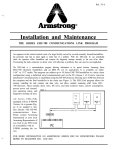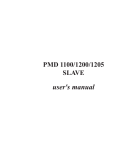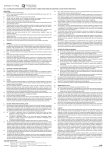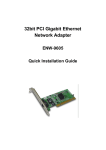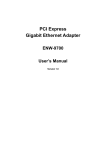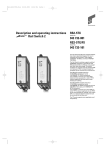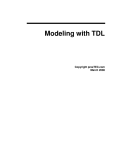Download Model 8277 Table of Contents
Transcript
Page 1 of 10 Model 8277 Multimode Fiber Optic Modem Reference Manual 0315-0292 Rev. F Printed 11.07.01 Table of Contents 1.0 Equipment Description 1.1 1.2 1.3 1.4 Introduction Optical Interface Electrical Interface Flow Control 2.0 Specifications 2.1 2.2 2.3 Optical Interface Electrical Interface General Specifications 3.0 Equipment Operation 3.1 3.2 Switch Options Connections 4.0 Indicators 5.0 Help Page 2 of 10 1.0 Equipment Description 1.1 Introduction The Model 8277 Multi-mode Fiber Optic Modem is an asynchronous product. The optical interface can operate in either point-to-point or ring configurations and employs two "ST-" type connections. The unit operates on fiber optic cables with core diameters from 50 to 100 microns. The electrical interface operates in either point-to-point or multi-drop configurations. When configured as RS-232 or RS-422 the unit will operate point-to-point. With the RS-485 interface selected, equipment can be multi-drop connected onto low-cost twisted-pair wire (see Figure 1). The versatility of the two interfaces of the Model 8277 allows for an extremely flexible system design. Figure 1 RS-485 Multi-drop Configuration Page 3 of 10 1.2 Optical Interface In an optical point-to-point configuration, two Model 8277s are connected back to back to form a simple, high-speed, full-duplex optical link. In optical ring operation, two or more 8277s are cascaded in a ring. A ring consists of one master modem and two or more slaves (see Figure 2). The slaves pass received optical data and transmit data from their electrical interface to their optical transmitters. The master does not pass received optical data. Master/slave modes are switch selectable. Master mode is selected for both modems in an optical point-to-point configuration. Figure 2 Optical Ring Note: In RS-485 two-wire mode (when configuring the Model 8277 in an optical ring) the master cannot be enabled by the "TD" signal. The Model 8277 optical interface can form a ring of up to ten units. This allows for a maximum optical system loss budget of 120 dB. In order to extend the optical distance between any two Model 8277s, the units are inserted in the optical path to act as line extenders. Slave mode should be selected for optical line extenders (see Figure 3). Figure 3 Extending Optical Distance Note: The Model 8277 transmits infrared light which is not visible to the eye. Page 4 of 10 1.3 Electrical Interface The Model 8277's electrical interface is switch selectable to RS-232 or RS-422/RS-485 voltage levels. When the RS-232 interface is selected, communications to the electrical interface are full-duplex point-to-point. With this interface, data can be transmitted onto the optical fiber for a point-to-point optical link or for an optical ring. Switch selection enables data to flow from the electrical interface to the optical transmitter or can be controlled by a high on RTS. On the electrical interface, a high on the Data In pin causes light to be emitted. Full-duplex (four-wire) or half-duplex (four- or two-wire) mode may be selected when the RS-422/RS-485 interface is selected. The RS-422/RS-485 interface of the Model 8277 can operate in a multi-dropped or point-to-point environment. If RS-422 mode is selected the electrical interface is only point to point. If the customer's equipment has an RS-485 interface, it can be multi-dropped directly onto the Model 8277's interface by selecting the four-wire or two-wire RS-485 mode. If the customer's equipment has an RS-232 interface, the equipment can be converted to a multi-drop, RS-485 interface by a Telebyte Model 285. Up to 31 units of the Model 285 can be multi-dropped onto the same electrical interface of the Model 8277. 1.4 Flow Control Operation in the RS-485 multi-drop or the ring environment requires that all devices connected to the line have some level of intelligence in order to establish an orderly flow of data. When RS-485 (half duplex) mode is selected, the Model 8277 controls the Receive Data line on the electrical interface. When data is not received (no light on fiber) by the optical receiver for ten microseconds, the output of the Receive Data electrical transmitter is tri-stated. In RS-485 mode this enables many transceivers to communicate on the same twisted pair. When the RS-485 two-wire mode is selected, half-duplex data is transmitted and received on the same twisted pair. Note: In RS-485 two-wire mode (when configuring the Model 8277 in an optical ring) the master cannot be enabled by the "TD" signal. Page 5 of 10 2.0 Specifications 2.1 Optical Interface Optical connectors: ST™ (trademark AT & T) Power Out: > +15 dBuW (32 microWatts), into 62.5/125 um core/clad fiber Power Budget: > 12 dB on 62.5/125 um core/clad fiber Wavelength: 850 nm, multi-mode Optical Configuration: Switch selectable, Master/Slave 2.2 Electrical Interface Electrical connector: DB-9, male Interface type: Switch selectable RS-232 (pinout conforms to RS-232) RS-422, or RS-485 Bit Rate: RS-232: 0 to 115.2 KBPS RS-4XX: 0 to 1 MBPS Interface Mode: Switch selectable. Unit can be configured to appear as a DCE or a DTE. 2.3 General Specifications Indicators: Four LEDs LTD Local Transmit Data FTD Fiber Transmit Data RD Receive Data COL Collision Power: +12 VDC @ 500ma Environment: 0 to 50 degrees Celsius Size: 5" W x 5.3" L x 1.7" H Page 6 of 10 3.0 Equipment Operation 3.1 Switch Options The Model 8277 is a versatile unit. It has many switch-selectable options that can be used to tailor it to different communications requirements. The switches are located on the side p anels. The following tables list the switch selections and their functions. Front Panel Switch Option Switch Name DCE/DTE Function DCE - Pin 2 is an input into the unit and Pin 3 is an output Factory Settings DCE DTE - Pin 2 is an output and Pin 3 is the input into the unit 232 422/485 Selects electrical interface. 232 is RS232 and 422 is RS-422 or RS-485. 232 Bottom Dip Switches DIP No. FUNCTION Factory Settings 1 ON – Connects pin 7 to pin 8 at the electrical interface. ON (CLOSE) 2 ON - Connects pin 4 to pin 9 at the electrical interface. ON (CLOSE) 3 ON – Close to terminate 4XX receiver. ON (CLOSE) 4 ON – Close for TDl Xmit Cont., Open RTS controls Xmit. ON (CLOSE) 5 ON – Close for a 4 wire, 422. OFF (OPEN) 6 ON – Close for 2 wire, 485 OFF (OPEN) 7 ON – Close for 4 wire, 485 OFF (OPEN) 8 ON – Close for Optical Master, Open slave ON (CLOSE) Page 7 of 10 3.2 Connections After the switches have been set properly, the connections to the Model 8277 I/O ports must be made. There are three groups of connections. These are the fiber optic interface, the electrical interface and the power interface. A minimum of two Model 8277s is required for communications. The connections to the fibers are through two ST connectors on the rear of the Model 8277. These are marked "T" for optical transmit and "R" for optical receive. The fibers between the two communicating Model 8277s must be cross connected (i.e., the optical transmitters must be connected to the optical receivers). The Model 8277’s optical power budget is specified as 12 dB, using 62/5 um core fiber. The units may use fibers with other core diameters. The table that follows specifies the loss budget for the different fibers. Max. Optical Loss Budget Core Max Loss (um) (dB) 50 8.6 62.5 12 85 14.3 100 16.2 The connections to the electrical interface are through the DB-9 connector located on the rear of the Model 8277. The signals on these pins are shown in the tables that follow. These signals (as well as their functions and directions) vary with the switch settings. Proper connection requires, at a minimum, the use of TD, RD and GND. The tables that follow show the signal names and their sources for the various settings of the DCE/DTE switch and the 232/4XX switch. The Model 8277 is powered from an external transformer supplied with the unit. The power transformer is plugged into 115 VAC and converts the 115 VAC to an unregulated DC voltage to be used by the unit. The connection to the transformer on the Model 8277 is located on the rear of the unit. A 220 VAC, 50 Hz transformer is available as an ordering option. Page 8 of 10 Electrical Interface Pinouts 3 2 7 5 Pin # 2 3 8 5 Pin # 3 1 2 6 7 4 5 Pin # 3 1 2 6 8 9 5 Pin # 3 1 7 4 5 Pin # 2 6 8 9 5 RS-232, Switch in DCE position Signal Signal Signal Function Generated by Generated by Model Customer 8277 TD X RD X RTS X GND RS-232, Switch in DTE position Signal Signal Generated Function by Customer TD X RD CTS X GND Signal Generated by Model 8277 X RS-422/RS-485, 4-wire, Switch in DCE position Signal Signal Generated by Signal Generated Function Customer Equipment by Model 8277 TDX TD+ X RDX RD+ X RTSX RTS+ X GND RS-422/RS-485, 4-wire, Switch in DTE position Signal Signal Generated by Signal Generated Function Customer Equipment by Model 8277 RDX RD+ X TDX TD+ X CTSX CTS+ X GND RS-485, 2-wire, Switch in DCE position Signal Signal Generated by Function Customer Equipment TD-, RDTDTD+, RD+ TD+ RTSX RTS+ X GND RS-485, 2-wire, Switch in DTE position Signal Signal Generated by Function Customer Equipment TD-, RDTDTD+, RD+ TD+ CTS+ X CTSX GND Signal Generated by Model 8277 RDRD+ Signal Generated by Model 8277 RDRD+ Note: When connecting to the Telebyte Model 285 the polarities of the TD and RD pins must be reversed. Page 9 of 10 4.0 Indicators There are four LED indicators located on the front panel of the Model 8277. These indicators can be used to see the status of the Model 8277 and equipment connected to it. Below is a list of the LEDs and their functions. LTD (Local Transmit Data) This LED is used to monitor the data coming into the electrical interface from the user's equipment. For RS-232 mode, a positive voltage on the data entering the Model 8277 turns this LED on when either one of the following conditions is met: a) With the DCE/DTE switch in the DCE position, Pin 3 (TD) will turn on the LED; or b) With the switch in the DTE position, Pin 2 (RD) will turn on the LED. For RS-4XX (with the DCE/DTE switch in the DCE position) a voltage more positive on Pin 6 (TD+) than on Pin 2 (TD-) turns this LED on. With the switch in the DTE position the line monitors are Pin 1 (RD+) and Pin 3 (RD-). Note: In RS-485 two-wire mode (when configuring the Model 8277 in an optical ring) the master cannot be enabled by the "TD" signal. FTD (Fiber Transmit Data) This LED turns on when light is transmitted from the optical transmitter. In the slave mode this is the logical "OR" of light coming into the optical receiver and a high on the data coming from the user at the electrical interface (LTD). In the master mode this is the same as LTD. FRD (Fiber Receive Data) This LED is used to monitor the data going into the optical receiver. The LED turns on when there is light on the fiber connected to the receiver. COL (Collision) This LED is used to monitor collisions on the fiber. This indicates a system problem. The COL LED turns on when the Model 8277 is being used in an optical ring and more than one slave is trying to transmit to the master unit. In the master mode this LED is disabled. Page 10 of 10 5.0 Help If you require assistance, please call Telebyte Customer Service at (631)423-3232, fax us at (631)385-8184 or e-mail us at [email protected]. Warranty TELEBYTE warrants the equipment to be free from defects in material and workmanship, under normal and proper use and in its unmodified condition, for 12 months, starting on the date it is delivered for use. TELEBYTE's sole obligation under this warranty shall be to furnish parts and labor for the repair or replacement of products found by TELEBYTE to be defective in material or workmanship during the warranty period. Warranty repairs will be performed at the point of manufacture. Equipment approved for return for warranty service shall be returned F.O.B. TELEBYTE factory and will be redelivered by TELEBYTE freight prepaid, except for non-continental U.S.A. locations. Non-continental deliveries will be sent COD freight plus import/export charges. The above warranty is in lieu of all other warranties, expressed or implied, statutory or otherwise, including any implied warranty of merchantability or fitness for a particular purpose. TELEBYTE shall not be liable for any damages sustained by reseller or any other party arising from or relating to any equipment failure, including, but not limited to consequential damages nor shall TELEBYTE have any liability for delays in replacement or repair of equipment. Out of warranty equipment may be returned to the Greenlawn, NY customer service facility prepaid as described above. Return shipping charges will be billed to the customer. The repaired unit will have a 90-day warranty. In those cases where "NO TROUBLE" is found, a reduced charge will be billed to cover handling, testing and packaging. Whether in or out of warranty, a Return Material Authorization (RMA) number is necessary and can be obtained by calling (631) 423-3232 or 1-(800) 835-3298, by faxing (631) 3858184/7060 or by e-mailing us at [email protected]. You can also visit us on the web at www.telebyteusa.com/rma.htm. Reference the RMA number on the outside container. Document No. 0315-0292/Rev. F Distributed by: L-com ® CONNECTIVITY PRODUCTS 45 Beechwood Drive North Andover, MA 01845 www.L-com.com E-mail: [email protected] Fax: 978-689-9484 Toll Free: 800-343-1455











